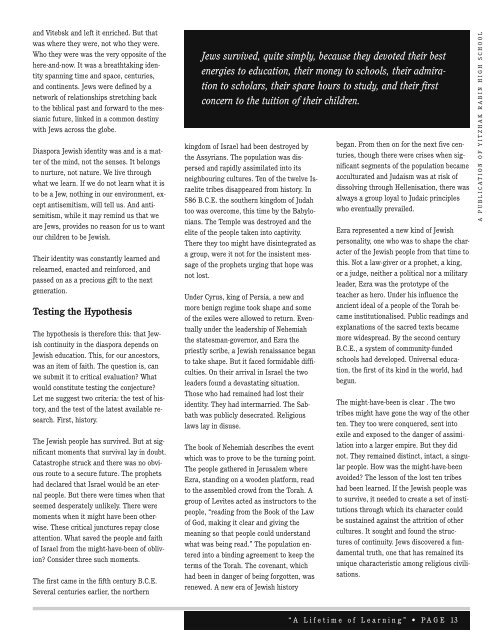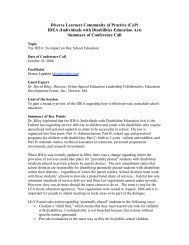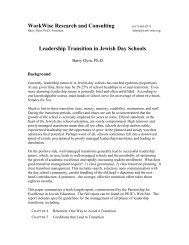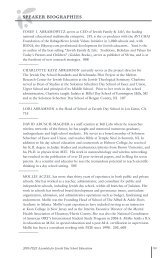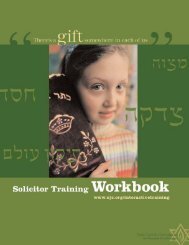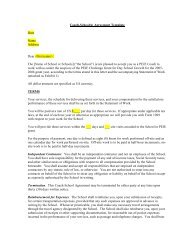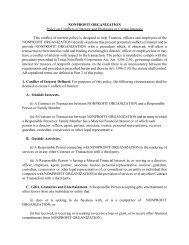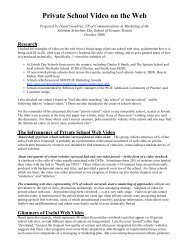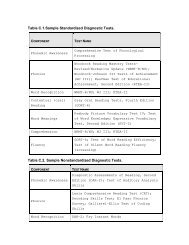âA Lifetim e of Learningâ - Partnership for Excellence in Jewish ...
âA Lifetim e of Learningâ - Partnership for Excellence in Jewish ...
âA Lifetim e of Learningâ - Partnership for Excellence in Jewish ...
You also want an ePaper? Increase the reach of your titles
YUMPU automatically turns print PDFs into web optimized ePapers that Google loves.
and Vitebsk and left it enriched. But thatwas where they were, not who they were.Who they were was the very opposite <strong>of</strong> thehere-and-now. It was a breathtak<strong>in</strong>g identityspann<strong>in</strong>g time and space, centuries,and cont<strong>in</strong>ents. Jews were def<strong>in</strong>ed by anetwork <strong>of</strong> relationships stretch<strong>in</strong>g backto the biblical past and <strong>for</strong>ward to the messianicfuture, l<strong>in</strong>ked <strong>in</strong> a common dest<strong>in</strong>ywith Jews across the globe.Diaspora <strong>Jewish</strong> identity was and is a matter<strong>of</strong> the m<strong>in</strong>d, not the senses. It belongsto nurture, not nature. We live throughwhat we learn. If we do not learn what it isto be a Jew, noth<strong>in</strong>g <strong>in</strong> our environment, exceptantisemitism, will tell us. And antisemitism,while it may rem<strong>in</strong>d us that weare Jews, provides no reason <strong>for</strong> us to wantour children to be <strong>Jewish</strong>.Their identity was constantly learned andrelearned, enacted and re<strong>in</strong><strong>for</strong>ced, andpassed on as a precious gift to the nextgeneration.Test<strong>in</strong>g the HypothesisThe hypothesis is there<strong>for</strong>e this: that <strong>Jewish</strong>cont<strong>in</strong>uity <strong>in</strong> the diaspora depends on<strong>Jewish</strong> education. This, <strong>for</strong> our ancestors,was an item <strong>of</strong> faith. The question is, canwe submit it to critical evaluation? Whatwould constitute test<strong>in</strong>g the conjecture?Let me suggest two criteria: the test <strong>of</strong> history,and the test <strong>of</strong> the latest available research.First, history.The <strong>Jewish</strong> people has survived. But at significantmoments that survival lay <strong>in</strong> doubt.Catastrophe struck and there was no obviousroute to a secure future. The prophetshad declared that Israel would be an eternalpeople. But there were times when thatseemed desperately unlikely. There weremoments when it might have been otherwise.These critical junctures repay closeattention. What saved the people and faith<strong>of</strong> Israel from the might-have-been <strong>of</strong> oblivion?Consider three such moments.The first came <strong>in</strong> the fifth century B.C.E.Several centuries earlier, the northernJews survived, quite simply, because they devoted their bestenergies to education, their money to schools, their admirationto scholars, their spare hours to study, and their firstconcern to the tuition <strong>of</strong> their children.k<strong>in</strong>gdom <strong>of</strong> Israel had been destroyed bythe Assyrians. The population was dispersedand rapidly assimilated <strong>in</strong>to itsneighbour<strong>in</strong>g cultures. Ten <strong>of</strong> the twelve Israelitetribes disappeared from history. In586 B.C.E. the southern k<strong>in</strong>gdom <strong>of</strong> Judahtoo was overcome, this time by the Babylonians.The Temple was destroyed and theelite <strong>of</strong> the people taken <strong>in</strong>to captivity.There they too might have dis<strong>in</strong>tegrated asa group, were it not <strong>for</strong> the <strong>in</strong>sistent message<strong>of</strong> the prophets urg<strong>in</strong>g that hope wasnot lost.Under Cyrus, k<strong>in</strong>g <strong>of</strong> Persia, a new andmore benign regime took shape and some<strong>of</strong> the exiles were allowed to return. Eventuallyunder the leadership <strong>of</strong> Nehemiahthe statesman-governor, and Ezra thepriestly scribe, a <strong>Jewish</strong> renaissance beganto take shape. But it faced <strong>for</strong>midable difficulties.On their arrival <strong>in</strong> Israel the twoleaders found a devastat<strong>in</strong>g situation.Those who had rema<strong>in</strong>ed had lost theiridentity. They had <strong>in</strong>termarried. The Sabbathwas publicly desecrated. Religiouslaws lay <strong>in</strong> disuse.The book <strong>of</strong> Nehemiah describes the eventwhich was to prove to be the turn<strong>in</strong>g po<strong>in</strong>t.The people gathered <strong>in</strong> Jerusalem whereEzra, stand<strong>in</strong>g on a wooden plat<strong>for</strong>m, readto the assembled crowd from the Torah. Agroup <strong>of</strong> Levites acted as <strong>in</strong>structors to thepeople, “read<strong>in</strong>g from the Book <strong>of</strong> the Law<strong>of</strong> God, mak<strong>in</strong>g it clear and giv<strong>in</strong>g themean<strong>in</strong>g so that people could understandwhat was be<strong>in</strong>g read.” The population entered<strong>in</strong>to a b<strong>in</strong>d<strong>in</strong>g agreement to keep theterms <strong>of</strong> the Torah. The covenant, whichhad been <strong>in</strong> danger <strong>of</strong> be<strong>in</strong>g <strong>for</strong>gotten, wasrenewed. A new era <strong>of</strong> <strong>Jewish</strong> historybegan. From then on <strong>for</strong> the next five centuries,though there were crises when significantsegments <strong>of</strong> the population becameacculturated and Judaism was at risk <strong>of</strong>dissolv<strong>in</strong>g through Hellenisation, there wasalways a group loyal to Judaic pr<strong>in</strong>cipleswho eventually prevailed.Ezra represented a new k<strong>in</strong>d <strong>of</strong> <strong>Jewish</strong>personality, one who was to shape the character<strong>of</strong> the <strong>Jewish</strong> people from that time tothis. Not a law-giver or a prophet, a k<strong>in</strong>g,or a judge, neither a political nor a militaryleader, Ezra was the prototype <strong>of</strong> theteacher as hero. Under his <strong>in</strong>fluence theancient ideal <strong>of</strong> a people <strong>of</strong> the Torah became<strong>in</strong>stitutionalised. Public read<strong>in</strong>gs andexplanations <strong>of</strong> the sacred texts becamemore widespread. By the second centuryB.C.E., a system <strong>of</strong> community-fundedschools had developed. Universal education,the first <strong>of</strong> its k<strong>in</strong>d <strong>in</strong> the world, hadbegun.The might-have-been is clear . The twotribes might have gone the way <strong>of</strong> the otherten. They too were conquered, sent <strong>in</strong>toexile and exposed to the danger <strong>of</strong> assimilation<strong>in</strong>to a larger empire. But they didnot. They rema<strong>in</strong>ed dist<strong>in</strong>ct, <strong>in</strong>tact, a s<strong>in</strong>gularpeople. How was the might-have-beenavoided? The lesson <strong>of</strong> the lost ten tribeshad been learned. If the <strong>Jewish</strong> people wasto survive, it needed to create a set <strong>of</strong> <strong>in</strong>stitutionsthrough which its character couldbe susta<strong>in</strong>ed aga<strong>in</strong>st the attrition <strong>of</strong> othercultures. It sought and found the structures<strong>of</strong> cont<strong>in</strong>uity. Jews discovered a fundamentaltruth, one that has rema<strong>in</strong>ed itsunique characteristic among religious civilisations.A P U B L I C A T I O N O F Y I T Z H A K R A B I N H I G H S C H O O L“ A L i f e t i m e o f L e a r n i n g ” • P A G E 13


